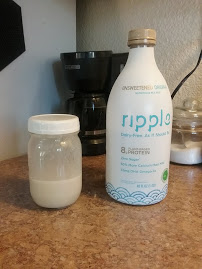
“HELP! My DYI Ripple doesn’t taste, look or feel like the store bought one!” And, it won’t. Ripple is made in a lab where they are able to isolate the pea protein from split peas while our home versions are, well, made in our kitchens. We do not have machines that can do that. Also they add oil and different gums that keep it homogenized and smooth. Last time I checked I could not just walk into the grocery store and buy guar gum. Don’t get me wrong. I have nothing against Ripple. In fact, now that I have tried it, I think it’s pretty good.
So why bother making my own? Certainly going to the store and buying a bottle is far more convenient and less time consuming. I’ll be honest. It’s the cost. In fact that’s why I choose to make my own hemp , coconut and almond milks. When the doctor says Matthew’s calories need to increase by 200 calories a day, the cash register goes off in my head. Let’s do the math. Each 48oz bottle of Ripple costs $4.99. That’s 6 cups. If each cup is 70 calories, I am going to need to add almost 3 cups a day to his current diet. So the bottle will only last about 2 days. Lets’ say I buy 3 bottles a week. That’s $15 a week or $60 a month just on Ripple! Since that is not an option for me (and I’m guessing not for you either) getting as close to taste, consistency and texture is my goal. I have made a new batch that is much closer and it does not separate. That post is coming soon.
In the mean time, if you are interested in seeing how Ripple is made, I found an interview sheds some light on how it’s made. Obviously the cost is somewhat justifiable with all that they have to do to make it taste the way it does. Personally, I’d rather adjust my taste buds a bit and spend the money elsewhere. But, if I’m in a pinch, I will not feel guilty about buying a bottle now and then.


i’m thinking of adding xanthan gum (which is basically guar gum i think?) and MCT oil to add fat and change the texture. do you think this would work? i also considered adding hemp hearts for fat too.
YES! Those are similar to what I have recently done to change the texture and keep it from separating. I am working on putting my adjustments into the current blog post or adding a new post all together. The new recipe uses the pressure cooker. Cuts the time way back.
hello! This may have been answered already, but before I start on this, what does this taste like? We gave up all animal products with no problem, except for milk. It has been hard. Have you ever used a soy milk maker to make soy, pea or other milks? Is it worth the investment? Thank you!
It tastes a lot like soy milk to me. If you are trying to transition, you will want to do it gradually. Make a small batch and start by adding a portion of it to the milk. Increase the amount until the cows milk is completely eliminated. There is a bit of texture but it’s less if you run the milk through a filtration bag. Also, don’t let the the smell while they are cooking deter you. Once it’s blended and cold, it is less noticeable. The dates and the vanilla help with the taste. As for the soy milk maker, I’ve never used one but I don’t see the value in it. I did watch a You-tube video to see how it works. I like using my Power Pressure Cooker XL because it saves time and I use it for lots of other things. Because split peas cook quickly, you can even do them on the stove in a reasonable amount of time. If you have a high end blender like the Vitamix, you really don’t need to go out and buy a soy milk maker.
thank you.
Have you looked into Konica flour at all? It is fairly inexpensive and it adds fiber as well as being a thickening agent like chia or flax.
Konjac * autocorrect…ugh
No I haven’t but I will check it out. Thank you for bringing it to my attention. What recipes have you used it in?
I got a chance to look into the Konjac flour. It definitely looks interesting. I’ll see if my bulk food store carries it. If not, I’m sure I can get some online. I was just about to make a new batch of split pea milk. I think I will wait and try adding it to see if it gives the milk a creamier texture. I will have to add a small amount since my recipe is fairly thick on its own.
Hiii do you have any recipe of the pea milk I can make ??
Hi Regina. Yes. My recipe for homemade split pea milk (DIY Ripple) is in the blog. Just type it into the search bar and it will pop up.